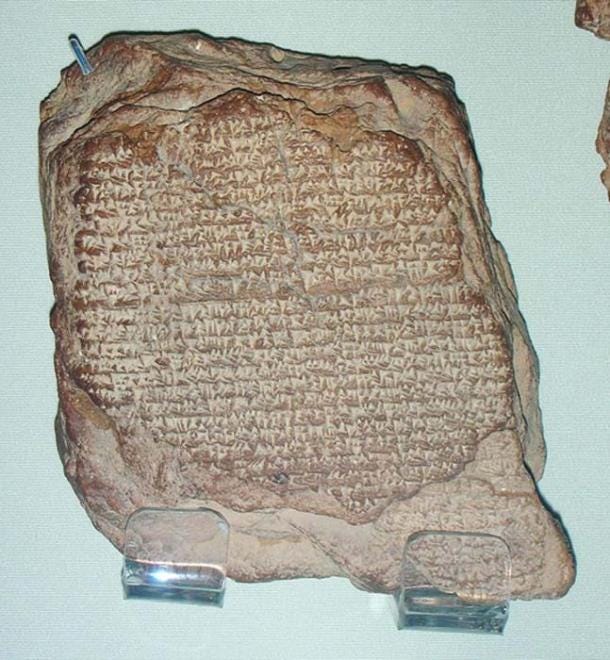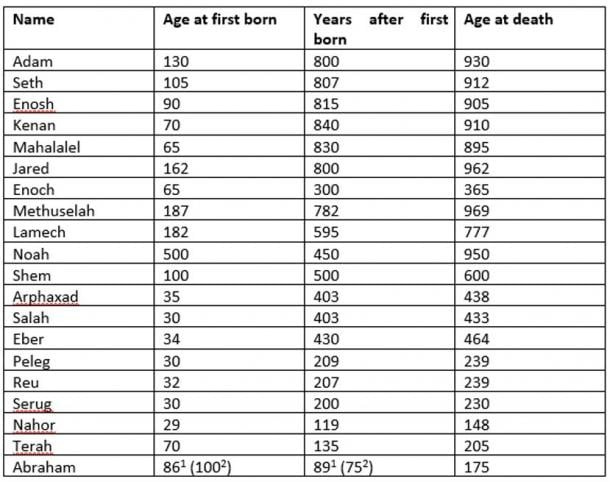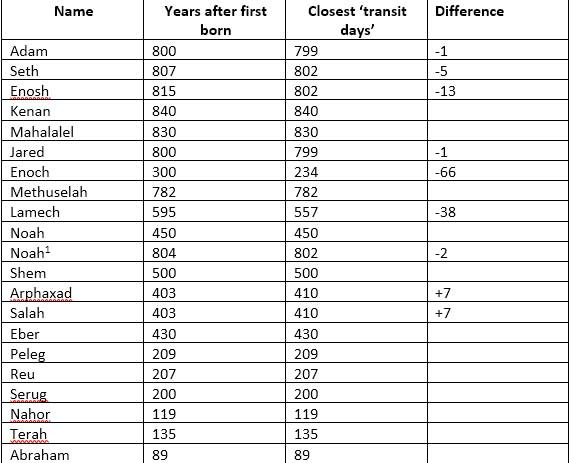Can the Babylonian Calendar Help Explain the Ages of Patriarchs Recounted in the Book of Genesis?
The ages of Adam and his descendants in the Book of Genesis appear incredulous when compared to the average lifespan of Man throughout history. Though there have been several attempts to justify the numbers mathematically, none can be applied to all cases equally. Can these outlandish figures be explained?
A Mixed-up Interpretation?
The problem is, not only does Genesis list the age of the patriarchs, it lists their age at the time of their firstborn child. For example, Methuselah was 187 when he had his first son and he died at the age of 969. Had the scribes incorrectly interpreted months as years in the source data, the figures would be exaggerated by a factor of 12, and Methuselah would have been a more believable 15 and 80 years respectively at each event. Unfortunately, that does not work so well for his father, Enoch, who was 65 when Methuselah was born, which equates to 5 years old, and less so for the generations after the flood, the majority of whom were less than 36 when the first son was born, which would imply they were only 3 years old.
The Flood Story
The 19th century discovery and subsequent translation of 12 cuneiform clay tablets from the 7th century BC revealed the ‘Epic of Gilgamesh’, a poem about a Mesopotamian king who is believed to have reigned around the middle of the 3rd millennium BC. The 11th tablet contains a Babylonian account of a great flood, which is similar to that described in the Book of Genesis, not only in its synopsis but also in the timing, the Biblical flood having occurred around 2348 BC when calculated using the dates of events and genealogy available in the Bible (the Ussher chronology).
Astronomical Diaries
Of the hundreds of tablets recovered from Mesopotamia, many contain astronomical diaries compiled from observers specifically trained and employed for keeping a regular watch on the location of the moon and planets (Mercury, Venus, Mars, Jupiter and Saturn) at various times each night. This involved recording the location of each of these objects as they approached one of 31 ‘Normal Stars’ close to the ecliptic (the apparent path of the Sun each year). Short diaries were filled with entries on a daily basis while the clay tablet was soft enough for an impression to be made. These were compiled into longer diaries to coincide with the beginning of the two half-years of the Babylonian calendar.
The diary contained not only astronomical observations but also phenomena - the solstices and equinoxes, the appearance of comets and meteors, weather conditions (mist, rain, cloud activity, winds and storms), commodity prices, river levels and notable events - the intention being the identification of patterns of behavior that could be used to interpret omens. Key to this principle was the proximity of one or more planets to one of the constellations, for example this omen from a 17th century BC tablet:
“If Venus comes close to Scorpius: winds which are not good will blow”

From this we might assume that, at some time in the past, abnormally strong winds were noted as the planet Venus was observed approaching the constellation of Scorpio. This developed into the wider interpretation of where planets would be in relation to the Babylonian zodiac, which divided the sky into 12 equal segments of 30°.
The initial process of observing when and for how long a planet occupied a sign or house (the transit) would have taken tens of years due to the orbit of the Earth relative to the other planets, which causes the planets to waltz across the sky, speeding up, slowing down, stopping and even reversing direction briefly, rather than simply passing from East to West like the Sun or Moon (the same effect from which Copernicus hypothesized it was the Sun, not the Earth, that was at the center of the universe). The transit time for Mercury, which takes a short 88 days to orbit the Sun, is around 14 to 30 days whereas Saturn, the farthest planet from Earth visible with the naked eye, takes over 29 years to complete an orbit and can stay anything from a few days to more than 3 years in a sign.

Comparing the Babylonian Saturn Calendar with Genesis Generations
In the table below, the entry and exit dates from a Saturn transit calendar have been used to reproduce half-year diaries. In keeping with the Babylonian calendar, the Entry Date was based on the number of days since the start of the first- or second-half of the year, which were around the time of the vernal and autumnal equinoxes respectively.
The Days before transit was then calculated as the difference in days between the Entry Date and the previous March 20th (the vernal equinox in the Northern Hemisphere). Where this value exceeded 182 days (half a year), the same was subtracted to yield the number of days in the second half of the year. The Transit Days were calculated as the number of days between the Entry Date and Exit Date. Finally, the Transit Days value was added to the Days before transit value to give the Total days for each entry:
Compare the table above to the generations of Man (below) compiled from the book of Genesis.

In each case Genesis states the age of the patriarch when the first son is born, the number of years until death and the age at death, for example:
“And Seth lived one hundred and five years, and he begot Enosh. And Seth lived after he had begotten Enosh eight hundred and seven years, and he begot sons and daughters. And all the days of Seth were nine hundred and twelve years, and he died.”
Source: Chabad.org
The list starts with Adam and continues through Noah in chapter 5 of Genesis. The process continues in chapter 11 of Genesis, i.e. after the flood story, starting with Noah’s son, Shem, and continues through Abram (Abraham) to provide a genealogy tracing Abraham’s sons, Ishmael and Isaac, to the first Man created by God.

Ignoring the units used in each, the numerical similarities in the relationships, and the orders of magnitude, between the second and third columns for the ‘Half-year diaries’ and the ‘Generations of Man’ are undeniable.
To be correct, the values in the ‘Age at first born’ column should not exceed half-a-year. Although a value of 182 days was used to create the half-year diaries from the transit calendar, the Babylonian calendar was 12 lunar months, each month being 29 or 30 days depending on the sighting of a new crescent Moon, yielding a year of around 354 days as opposed to 365 in our (Gregorian) calendar. And whereas we insert one day every four years to compensate for the difference between our year and a solar year, the Babylonians inserted one month every 3 years after either the 6th or 12th month.
The maximum value for Age at first born could then be equal to seven lunar months, or 206. Indeed, only in the case of Noah is that value exceeded, that too as a prelude to the flood suggesting this particular diary contained references to heavy rainfall, high river levels and cloudy conditions that prevented Saturn from being observed for a period of around one year - an omen in the making. One possible explanation for this would be a large volcanic event.
Another notable exception in the generations before the flood is Enoch, whose death at 365 years is significantly less than the others. Apart from Noah, Enoch is the only other patriarch to be afforded special consideration in Chapter 5 of Genesis:
“And Enoch lived sixty five years, and he begot Methuselah. And Enoch walked with God after he had begotten Methuselah, three hundred years, and he begot sons and daughters. And all the days of Enoch were three hundred and sixty five years. And Enoch walked with God, and he was no longer, for God had taken him.”
Source: Chabad.org

This is in contrast to every other patriarch whose short eulogy always ends with ‘… and he died’. The apologist’s explanation for Enoch’s unusually short life and unique relationship with God is that he constantly set God before himself - for which he was spared a natural death. It could also be that the author or scribe of Genesis has in this particular diary misinterpreted the reference to an astrological ‘exaltation’.
An exaltation in astrology occurs when a planet is in a sign of a similar nature, but which it does not rule, and embodies the planet with strength and energy (as opposed to the literal use of exaltation, which is a state of bliss or the action of elevating a person’s status). In late Babylonian sources the exaltations are referred to as the ‘secret houses’ or ‘secret places’, which the author could be forgiven for mistaking as a special place to which Enoch was taken some 500 years before he was expected to die.
In the second and concluding part, we take a more detailed look at values for Saturn’s transit through the houses and the possibility that the ages of Adam and his descendants have their origin in Babylonian astronomical diaries.
Modern Calculations
Prometheus astrology software was used to compare the order of magnitude for the Age after first born with the transit days for Saturn. The software is capable of calculating the location of celestial objects at any point in time from which it is possible to determine the date and time that the Sun, Moon or a planet exits one sign or house and enters the next. A database of 1,937 transits for Saturn through the 12 houses was generated for the period 2300BC and 1BC, which reflects the earliest known Sumerian interest in omens as well as providing a large sample. The houses were used instead of the signs because they are more representative of the Babylonian zodiac system of 12 equal segments of 30°. The Years after first born value for each patriarch was then compared against computed transit days to find the closest match:
Note: Noah 1 age based on a corrected Age at first born value equal to 146 (500 - 354), although this value is only representative. Though the Years after first born value for Noah (450) had an exact match in the database it has been omitted in the analysis below.
Note: Probability 1 of a number matching by chance based on 506 distinct transit days values in the range 11 to 1,220 in the computed data. These values were used to generate all additional values in the range ±n using the formula round (transit days / 354 * n) yielding 636 in 1,223; 829 in 1,244; and 1,134 in 1,322 distinct values for ±1 days; ±7 days; and ±29.5 (I.e. the average lunar month) respectively.
Considering the Margin of Error
With the exception of Enoch, who has already been identified as a special case in Genesis, the Years after first born values for the patriarchs show a high correlation with the possible transit days for Saturn passing through the houses, especially when taking into consideration factors that could affect the accuracy of the observations, completeness of the data in compiling a diary, condition of each tablet when translated and the ability of the author(s) to understand the content.
For example, in Enoch’s case it cannot go unnoticed that the difference in days is almost the same as his Age at first born, which might be construed as an error introduced at some point, i.e. the Age at death was actually 300, not 365. However, this comparison is only intended to show the likelihood that the data used to compile the generations of Man was acquired from the Babylonian astronomical diaries. The generations of Man per se is not a transit calendar and there are too many unknowns to place the data at a point in history including: the often arbitrary insertion of intercalated months in the Babylonian calendar; provenance of the tablets; personal or political motive in determining the sequence; and errors introduced by scribes in subsequent copying, any one of which could result in an erroneous Years after first born. Also, in the absence of the actual Babylonian calendar for the period in question, the Days before transit values have been calculated from the computed Entry date for each transit based on the Gregorian calendar, so there is no point in trying to narrow down the historical date by matching this value with Age at first born.
An Incomplete Account
The Hebrew Bible cannot be relied upon as the word of God or even as a reliable historical document because it is not a chronological compilation. The stories, teachings and commentaries on which all Bibles are based emerged during the period of Roman domination of the Jews in Palestine and contain only a selection of the known historical documents available at the time (the others surviving as inclusions in subsequent variations of the Bible or as separate accepted sacred texts). However, the Bible as a single book only appears around 800AD before which it existed as a collection of scrolls, increasing the possibility that the final content was edited, and many contemporary manuscripts that have emerged since that time contradict what we know as ‘The Bible’. The content has also been subjected to interpretation and translation, most significantly into Greek and Latin, the latter of which saw the introduction of 27 additional books (the New Testament in the Catholic Bible) following the adoption of Christianity by the Roman Empire. Though the content and arrangement of books may be different across the many traditions and divisions of the Christian religion, the first five books of the original Hebrew Bible (The Pentateuch) persist to form the basis of monotheism, the story of creation, the genealogical record before and after the flood, and the birth of the Jewish nation.
According to William Propp, an expert on the history and interpretation of the Hebrew Bible and former Associate Professor of Ancient Near Eastern History and Judaic Studies at the University of California:
“... when it comes to Genesis through Second Kings, sometimes called the primary history, it’s not really clear who the authors are … Some of the descriptions appear to be eyewitness and occasionally we can show that we can corroborate events described from Babylonian chronicles or whatever but the anonymous historians [of the primary history] must often have relied upon a variety of sources; royal chronicles, possibly treasury records, folk tales, earlier efforts at historiography …”
William Propp, “Origins of the Bible” presentation Colloquium 2015
Borrowing from the Babylonians
There can be no doubt that the Judeans borrowed frequently from the Babylonians in compiling a prehistory for their national roots and the basis for their religion, which may have emerged during a period of captivity in Babylon following the fall of Jerusalem. The Babylonian astronomical diaries would have provided a historical framework to link ideology with oral traditions that had survived since the time of Abraham. If correct, the legitimacy of Genesis as an accurate record of history falls apart because Ussher’s date for creation must be adjusted by at least -1,576 years (based on 19 patriarchs being 25 years on average when the first son is born and Abraham living to 70 years), placing it at 2428BC, well within the recorded history of the ancient Sumerians and Early Dynastic Period of Egypt. It would also challenge the existence of the patriarchs as a credible list linking Abraham, the father of monotheistic religions, to Adam.
Top image: Episodes in the book of Genesis. Oil painting by a Spanish painter. Iconographic Collections. CC BY 4.0/ Bible Primer, Old Testament (Public Domain)
By Dean Talboys
Dean Talboys is the author of The Stonehenge Observatory.
References
Propp, William, Origins of the Bible, 2015
Sachs, A. J., Astronomical Diaries and Related Texts from Babylonia, (completed and edited by H. Hunger), 1988
Ussher, Rev. J., The Annals of The World, 1658
White, Gavin, The Exaltation System in Babylonian Astrology, 2009






Atheist bullschiff
Interesting hypothesis. I am not qualified to judge it on the merits. However, on the setting and time of the Adam and Eve story as traditionally conceived (somewhere in Mesopotamia, early 4th millennium BC) I cannot help but be struck by the fact that this is where and when military conquest began as a wide scale phenomenon, leading to the establishment of the world's first civilization in that region. Is that just a coincidence? Would be interested in your response to this paper in which I make the case: https://docs.google.com/document/d/10q-cx2v05UnAsHb9BaRBZqYtPljiMZ52h6UxvHj0duA/edit?usp=sharing
I guess my question is, how sure are you of your take on these questions?
Thanks,
Luke